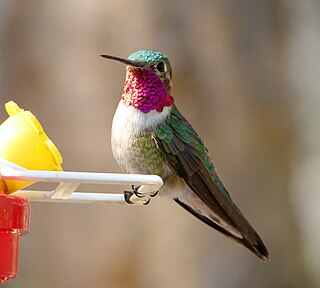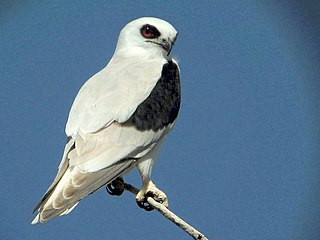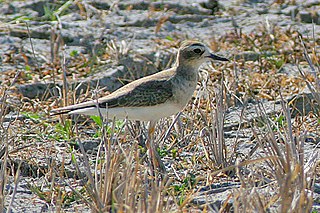
The eastern marsh harrier is a bird of prey belonging to the marsh harrier group of harriers. It was previously considered to be conspecific with the western marsh harrier but is now usually classified as a separate species. It has two subspecies: C. s. spilonotus in eastern Asia and C. s. spilothorax in New Guinea.

The rufous hummingbird is a small hummingbird, about 8 cm (3 in) long with a long, straight and slender bill. These birds are known for their extraordinary flight skills, flying 3,200 kilometres during their migratory transits. It is one of nine species in the genus Selasphorus.

The pigeon guillemot is a species of bird in the auk family, Alcidae. One of three species in the genus Cepphus, it is most closely related to the spectacled guillemot. There are five subspecies of the pigeon guillemot; all subspecies, when in breeding plumage, are dark brown with a black iridescent sheen and a distinctive wing patch broken by a brown-black wedge. Its non-breeding plumage has mottled grey and black upperparts and white underparts. The long bill is black, as are the claws. The legs, feet, and inside of the mouth are red. It closely resembles the black guillemot, which is slightly smaller and lacks the dark wing wedge present in the pigeon guillemot.

The black-and-white warbler is a species of New World warbler, and the only member of its genus, Mniotilta. It breeds in northern and eastern North America and winters in Florida, Central America, and the West Indies down to Peru. This species is a very rare vagrant to western Europe.

The swamp sparrow is a medium-sized New World sparrow related to the song sparrow.

The standard-winged nightjar is a nocturnal bird in the nightjar family. Previously placed with the pennant-winged nightjar in their own genus, Macrodipteryx, it is native to Africa and displays extreme sexual dimorphism. During the breeding season, males will grow broad ornamental flight feathers longer than their body.

The varied triller like its better-known relative the white-winged triller, is a smaller member of the cuckoo-shrike family, Campephagidae. Varied trillers prefer warm, reasonably moist environments and are found in New Guinea and the Bismarck Archipelago, along much of the tropical and sub-tropical coastal hinterland of eastern Australia, from about the Sydney area to the tip of Cape York Peninsula, in the moister part of the Kimberley, and throughout the Top End.

The broad-tailed hummingbird is a medium-sized hummingbird species found in highland regions from western United States and Western Canada to Mexico and Guatemala.

The square-tailed kite is a medium-sized bird of prey in the family Accipitridae, which also includes many other diurnal raptors such as kites, eagles and harriers.

The tiger shrike or thick-billed shrike is a small passerine bird which belongs to the genus Lanius in the shrike family, Laniidae. It is found in wooded habitats across eastern Asia. It is a shy, often solitary bird which is less conspicuous than most other shrikes. Like other shrikes it is predatory, feeding on small animals. Its nest is built in a tree and three to six eggs are laid.

The chestnut sparrow is a species of passerine bird in the sparrow family Passeridae. It is the smallest member of the sparrow family, at about 11 cm (4.3 in) long. The breeding male has deep chestnut plumage and the female and juvenile are coloured a duller grey with some chestnut markings. Like its closest relatives in the genus Passer, the Arabian golden sparrow and the Sudan golden sparrow, it is gregarious and found in arid areas. Ranging through the east of Africa from Darfur in Sudan to Tanzania, it is found in dry savanna, papyrus swamps, and near human habitation. Adults and juveniles both feed mostly on grass seeds, and fly in flocks, often with other species of birds, to find food. It nests in trees, building its own domed nests, and also usurping the more elaborate nests of weavers.

The letter-winged kite is a small, rare and irruptive bird of prey that is found only in Australia. Measuring around 35 cm (14 in) in length with a wingspan of 84–100 cm (33–39 in), the adult letter-winged kite has predominantly pale grey and white plumage and prominent black rings around its red eyes. Its name derives from its highly distinctive black underwing pattern of a shallow 'M' or 'W' shape, visible when in flight. This distinguishes it from the otherwise similar black-shouldered kite. This species is also the only nocturnal species within the order Accipitriformes despite few differences found in its visual anatomy to other closely related kites.

The oriental plover, also known as the oriental dotterel, is a medium-sized plover closely related to the Caspian plover. It breeds in parts of Mongolia and China, migrating southwards each year to spend its non-breeding season in Indonesia, New Guinea and northern Australia.

The white-shouldered triller is a passerine bird belonging to the triller genus Lalage in the cuckoo-shrike family Campephagidae. It is found in Indonesia and East Timor. The white-winged triller of Australia and New Guinea was formerly included in this species but is now treated as a separate species.

The black-and-white triller is a species of bird in the family Campephagidae. It is endemic to the Philippines. Its natural habitat is tropical moist lowland forests.

The red-winged fairywren is a species of passerine bird in the Australasian wren family, Maluridae. It is non-migratory and endemic to the southwestern corner of Western Australia. Exhibiting a high degree of sexual dimorphism, the male adopts a brilliantly coloured breeding plumage, with an iridescent silvery-blue crown, ear coverts and upper back, red shoulders, contrasting with a black throat, grey-brown tail and wings and pale underparts. Non-breeding males, females and juveniles have predominantly grey-brown plumage, though males may bear isolated blue and black feathers. No separate subspecies are recognised. Similar in appearance and closely related to the variegated fairywren and the blue-breasted fairywren, it is regarded as a separate species as no intermediate forms have been recorded where their ranges overlap. Though the red-winged fairywren is locally common, there is evidence of a decline in numbers.

The white-winged fairywren is a species of passerine bird in the Australasian wren family, Maluridae. It lives in the drier parts of Central Australia; from central Queensland and South Australia across to Western Australia. Like other fairywrens, this species displays marked sexual dimorphism and one or more males of a social group grow brightly coloured plumage during the breeding season. The female is sandy-brown with light-blue tail feathers; it is smaller than the male, which, in breeding plumage, has a bright-blue body, black bill, and white wings. Younger sexually mature males are almost indistinguishable from females and are often the breeding males. In spring and summer, a troop of white-winged fairywrens has a brightly coloured older male accompanied by small, inconspicuous brown birds, many of which are also male. Three subspecies are recognised. Apart from the mainland subspecies, one is found on Dirk Hartog Island, and another on Barrow Island off the coast of Western Australia. Males from these islands have black rather than blue breeding plumage.

The blue-breasted fairywren, or blue-breasted wren, is a species of passerine bird in the Australasian wren family, Maluridae. It is non-migratory and endemic to southern Western Australia and the Eyre Peninsula in South Australia. Exhibiting a high degree of sexual dimorphism, the male adopts a brilliantly coloured breeding plumage, with a bright blue crown, ear coverts and upper back, red shoulders, contrasting with a dark blue throat, grey-brown tail and wings and pale underparts. Non-breeding males, females and juveniles have predominantly grey-brown plumage. No separate subspecies are recognised.

The Australian pratincole is a species of bird in the family Glareolidae. It breeds in Australia's interior and winters in northern and eastern parts of the continent, Indonesia and New Guinea. It is a medium-sized nomadic shorebird but is commonly found in arid inland Australia. It breeds predominantly from south-western Queensland to northern Victoria, and through central Australia to the Kimberley region in Western Australia. The Australian population is estimated at 60,000 individuals.

Lalage is a genus of passerine birds belonging to the cuckooshrike family Campephagidae, many of which are commonly known as trillers. There are about 20 species which occur in southern Asia and Australasia with a number of species on Pacific islands. They feed mainly on insects and fruit. They build a neat cup-shaped nest high in a tree.























